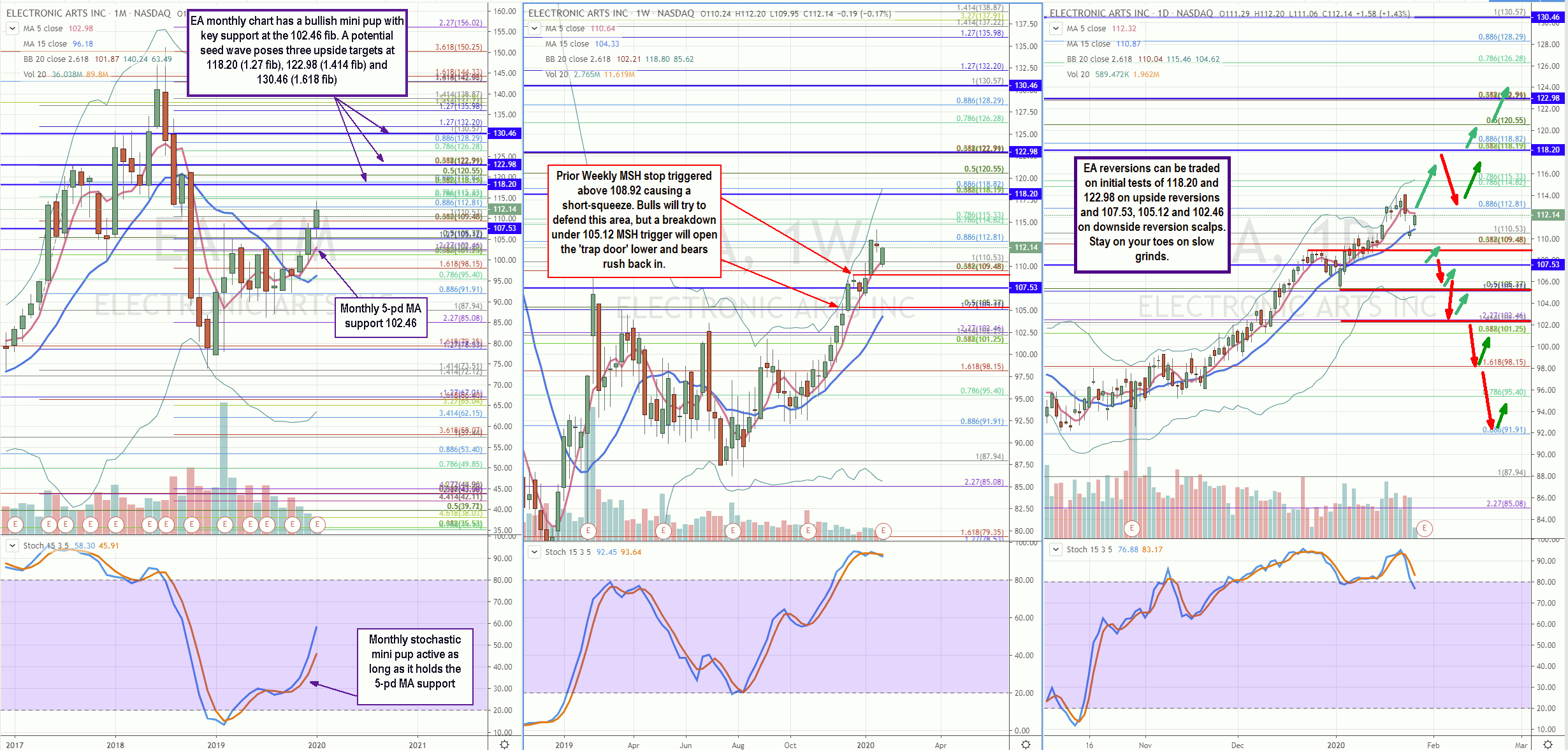Video game maker
Electronic Arts (NASDAQ: EA) reports Q4 2019 earnings after the close on Thursday, Jan.30, 2020. This industry leader will provide a lens into the video gaming space and setting the template moving forward with peer stocks. There’s been much controversy over the lack of evolution and originality with new releases as video game makers have relied on modifying legacy brands and abusing microtransactions to squeeze gamers. Whether complacency and lack of innovation have reached the tipping point should be revealed in EA’s forward guidance. Analysts are expecting $2.36-earnings per share (EPS) on revenues of $19.503 billion. The release of next-gen consoles expected in the latter part of 2020 could help bolster FY 2020 guidance, but this goes back to whether gamers will tolerate rehashes of legacy brand titles.
Macro Context and Influences
The S&P 500 ETF (NYSEARCA: SPY) is our macro market indicator. The FOMC rate decision on Wednesday, Jan. 28, 2020, will impact the SPY heading into EA earnings the following day. The SPY has managed to hold the breakeven line at 323.50 as it attempts to recover losses earlier in the week. The reaction to Chairman Powell’s Q&A session will set the tone on Thursday as it whether SPY gains will accelerate or be cut-off with 328.12 as the daily 5-period MA nominal recovery line I the sand.

Technical Analysis
Utilizing the rifle charts, EA has a bullish monthly stochastic mini pup with support at 102.46. Additionally, it may have formed a monthly seed wave that project upside potential reversal zones (PRZ) at the 1.27 fib 118.20, 1.414 fib at 122.98 and 1.618 fib at 130.46. The PRZ act as initial targets for longs and short-sell areas for bears to play countertrend reversions. The ultimate short-sell area is the 1.618 PRZ at 130.46 if it gets there. The weekly chart shows how the initial market structure high (MSH) formed at 108.92 setting the MSH sell trigger under 105.12. However, the trigger never formed as bulls drove shares back up through the 108.92 MSH triggering a short-squeeze to 114.13 highs before forming a weekly doji and reversion back to the weekly 5-pd MA 110.64 that managed to coil to the 112.32 daily 5-pd MA make or break ahead of earnings.
Sympathy Stocks:
The two top sympathy peer stocks to watch are Activision (NASDAQ: ATVI) and Take Two Interactive (NASDAQ: TTWO). Lower tier sympathy stocks include retailer GameStop (NYSE: GME), and mobile video game makers Glu Mobile (NASDAQ: GLUU) and Zynga (NASDAQ: ZNGA), which may react no EA’s mobile gaming segment figures.
Trading Game Plan: Post-Market Release
EA can trade very thinly post-market due to the high price and very wide spreads expected. Only the most experienced and agile seasoned traders with direct access order routing capabilities should even consider playing the post-market reactions. Scalp sizes can range from 0.25 to 2.00 on initial reactions. With that said, the most viable reversion areas to consider enveloping on the initial release reaction would be the 118.20, 122.98 on the upside reversion and 105.12 and 102.46 on the downside reversion. The next 1.618 fib sit at 98.15 which nearly overlaps with the monthly 15-period MA. Light sizing and quick exits are key. More extreme reversion levels would be the 127.50 and 130.46 PRZ area. IF EA manages to climb to the final PRZ range of 130.46, then shorts are highly viable for a multiple point reversion, unless it’s a slow grind. If EA collapses to 91.91, that would be a prime reversion bounce area into the 5 pm conference call.
Trading Game Plan: Next Day Market Open
Assuming there is a playable gap Friday morning, make sure you’re well familiarized with the three-reactions off the open on gappers. Scalps can range from .20 to 1.50 on the opening volatility. Use the fib reversion levels for the second reaction scalps. Be aware that EA can be notorious for intraday slow grinds that keep the stochastic pinned above 80-band or below 20-band to trap reversion players. Therefore, keep your sizing slow and consider scaling into positions to optimize your average price, but not too big so you can’t take stops.
Short-Stacked Trading Accounts
If you’re trading account is under $50,000 then remember pitfall #2 short-stacked accounts are too susceptible to smoked on expensive and volatile stocks like EA. Consider playing sympathy stock ATVI and using EA as a lead indicator at half the price. Always note the presence of negative correlation also known as divergence on peers ATVI and TTWO. For example, if EA sells-off on the market open and bounces back up through the 5-period MA but ATVI and TTWO continue to sell-off lower, then divergence has set in. This means either EA will fall or ATVI and TTWO will bounce as EA grinds higher. Ultimately these three stocks will resume movement in unison making divergence periods potential profit opportunities.
Before you make your next trade, you'll want to hear this.
MarketBeat keeps track of Wall Street's top-rated and best performing research analysts and the stocks they recommend to their clients on a daily basis.
Our team has identified the five stocks that top analysts are quietly whispering to their clients to buy now before the broader market catches on... and none of the big name stocks were on the list.
They believe these five stocks are the five best companies for investors to buy now...
See The Five Stocks Here
Looking to avoid the hassle of mudslinging, volatility, and uncertainty? You'd need to be out of the market, which isn’t viable. So where should investors put their money? Find out with this report.
Get This Free Report